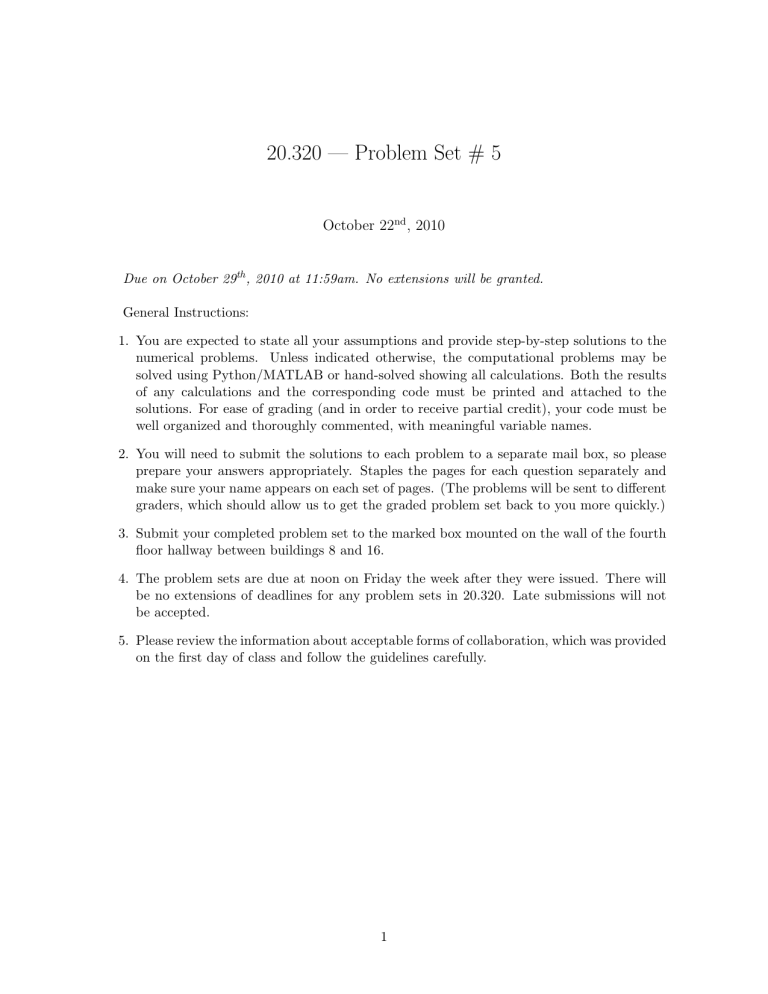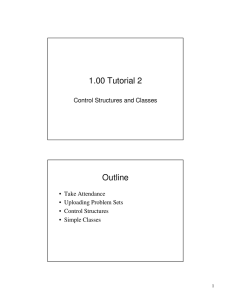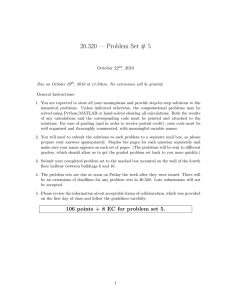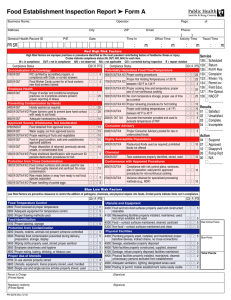— Problem Set # 5 20.320 22 2010
advertisement

20.320 — Problem Set # 5 October 22nd , 2010 Due on October 29th , 2010 at 11:59am. No extensions will be granted. General Instructions: 1. You are expected to state all your assumptions and provide step-by-step solutions to the numerical problems. Unless indicated otherwise, the computational problems may be solved using Python/MATLAB or hand-solved showing all calculations. Both the results of any calculations and the corresponding code must be printed and attached to the solutions. For ease of grading (and in order to receive partial credit), your code must be well organized and thoroughly commented, with meaningful variable names. 2. You will need to submit the solutions to each problem to a separate mail box, so please prepare your answers appropriately. Staples the pages for each question separately and make sure your name appears on each set of pages. (The problems will be sent to different graders, which should allow us to get the graded problem set back to you more quickly.) 3. Submit your completed problem set to the marked box mounted on the wall of the fourth floor hallway between buildings 8 and 16. 4. The problem sets are due at noon on Friday the week after they were issued. There will be no extensions of deadlines for any problem sets in 20.320. Late submissions will not be accepted. 5. Please review the information about acceptable forms of collaboration, which was provided on the first day of class and follow the guidelines carefully. 1 1 Feed-forward loops, gene circuit design, and cellular logic a) Consider the following feed-forward loop motifs: x x x x y y y y z A z B z C z D i) For each motif, state whether it is coherent or incoherent. ii) FFL (C) is commonly found regulatory networks governing metabolism. Find an ex­ ample of it in glycolysis, state the molecular identity of x, y, and z, and briefly state the biological function of the FFL. iii) For FFL (B), draw the response of y and z to the input x sketched below with initial conditions (x0 , y0 , z0 ) = (0, 1, 1) for both the AND-gated and the OR-gated case at z: x � t b) You are designing a synthetic gene network that will enable an engineered gut bacterium to secrete three specific toxins, z1 , z2 , and z3 , in a strictly sequential fashion upon detecting a pathogen. Using the input, x, only once in your network motif, design a simple FFL circuit which will i) start secreting them sequentially such that z1 secretion begins before z2 secretion and z2 secretion begins before z3 secretion. ii) secrete z1 briefly, then stop; secrete z2 briefly starting after secretion of z1 has ceased, then stop; and secrete z3 briefly starting after secretion of z2 has ceased, then stop. z1 and z3 secretion should not overlap in time at all; they each may overlap a little with z2 secretion. For each case, suggest why this might be useful. 2 2 Transcriptional regulation, feedback, and sensitivity Let x = [pX] denote the concentration of a transcription factor, pX. a) Consider the following differential equation for x: ẋ = P0 + Px x − ax KD + x Comment on the origin and meaning of each term in the equation. Identify which quantities are state variable(s) and which quantities are parameter(s) of the system. b) How would this equation change if only the dimeric species, pXpX, were capable of binding to its cognate promoter sequence? Derive the relevant expression, starting with a full (not yet simplified) reaction network. You may simplify your initial model by assuming rapid equilibrium at the dimerization stage (that is, the rates of dimer formation and dissociation, ka and k−a , are much greater than those of dimer binding to DNA, kb and k−b ) and by lumping transcription and translation. c) EXTRA CREDIT: The term −ax can arise by dilution even in the absence of any enzy­ matic action. Explain how, and derive it. d) In , analyze the transcription factor concentration as a function of time as follows, for both the monomeric and the dimeric activator for a = 1.2, KD = 0.4, Po = 0.05, and Px = 1 (relative units). Note that you do not need to run any simulations here. i) Plot the absolute value of the positive terms and the absolute value of the negative term in the same figure for each case (i.e. create a rate plot). ii) What do the intersections of your lines signify? iii) For the monomeric and the dimeric activation case separately, state if and justify briefly why or why not this feedback loop can govern a cell decision process. e) The expression for transcriptional activation you obtained above can be generalized to the Hill equation, xnH e = nH KD + x nH for the fractional activation of a promoter by pX. Use it to replace the corresponding term in your model to answer the following questions: i) How does the system’s behavior change as nH is varied? Is the system robust or sensitive with respect to nH ? ii) What is this kind of sensitivity analysis called? iii) How can you use it to improve a computational model? Give one example of improve­ ments it can help you implement. f) You want to model the therapeutic effect of RNAi-mediated downregulation of pX. Let r denote the concentration of an siRNA (treated as an input to the system). How do you need to modify your equations? Draw a full reaction network and write down a system of ODEs to follow the minimal set of relevant species over time. 3 3 Interlinked positive feedback loops Positive feedback allows systems to convert graded inputs into decisive, all-or-none outputs. Here you will explore the benefits of multiple interlinked positive feedback loops rather than using a single one. This exercise is highly relevant since many biological processes rely on these networks such as calcium signaling, polarization of budding yeasts or p53 regulation. Here we consider two systems described by the schematic below: A Single Loop Dual loop Stimulus Stimulus Output Output A B The system is governed by the following differential equations: = kout, on · (A + B) · (1 − OUT) − kout, off · OUT + kout, basal ( ) OUTn Ȧ = Stimulus · · (1 − A) − A + kbasal · aA OUTn + ECn50 ( ) OUTn Ḃ = Stimulus · · (1 − B) − B + kbasal · aB OUTn + ECn50 OU˙ T a) This model neglects a great deal of biological processes such as translation, transport, and post-translational modifications. Furthermore, the term (1-OUT) allows the system to be stable. What is the significance of all the other terms and parameters of this system? Identify all state variables and parameters, and comment on the form of each functional term. b) Using the parameters given in the table below, plot the simulation over 1000 seconds for 5 different systems with three constant stimulus from t1 = [30,50], t1 = [100,600], t1 = [750,770]. Hint: for this problem, we will solve the system numerical using Euler’s integration method. You have been provided with a code that will solve the system for you. All you need to do is plot the right conditions. i) One slow loop ii) Two slow loops iii) One fast loop iv) Two fast loops v) One slow loop + one fast loop 4 Parameter kout,on kout,of f kout,basal kbasal n EC50 Fast loop a Slow loop a Value 2 3 0.001 0.01 3 0.35 0.5 0.008 c) What differences do you see between these networks? d) As we have discussed in class, the robustness to noise is an important attribute for some networks. Now, instead of a constant stimulus, repeat your simulations in question b but with a noisy signal. Hint: Use randomly generated stimulus between 0 and 1 alternating with ∆ t of 5 seconds. For this you may use the function rand. e) How do these networks differ now? f) Can you envision a condition when the system would be even more resistant to noise? g) What is the advantage of having interlinked fast and slow positive feedback loops? 5 MIT OpenCourseWare http://ocw.mit.edu 20.320 Analysis of Biomolecular and Cellular Systems Fall 2012 For information about citing these materials or our Terms of Use, visit: http://ocw.mit.edu/terms.







